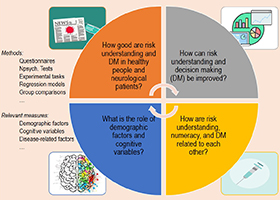- 2.8Impact Factor
- 5.6CiteScore
- 17 daysTime to First Decision
Neuropsychological Research of Risk Understanding and Decision Making: Normal and Pathological Profiles
This special issue belongs to the section “Cognitive, Social and Affective Neuroscience“.
Special Issue Information
Dear Colleagues,
The COVID-19 pandemic is an event that has invasively affected all aspects of our lives. It required (and still requires) a radical change in our everyday habits and a series of health-related decisions. Understanding numerical information and risks is essential for making skilled, informed decisions in risk situations. Previous research has mostly investigated risk understanding and decision making in healthy people, but little is known as to how patients with neurological conditions and specific neuropsychological deficits handle risk situations. This Special Issue of Brain Sciences aims to present a collection of studies regarding risk comprehension and decision making in healthy people and in neurological patients (e.g., early dementia, Parkinson’s disease, restless leg syndrome). Through this Special Issue, we will gain new insights into the possible changes in risk understanding and decision making that are related to, for example, normal or pathological aging. This is nowadays very relevant, as pandemic outbreaks require the understanding and compliance of the whole population, including the proportion of individuals with neurological conditions. Original research papers, meta-analyses, and critical reviews advancing our understanding of risk understanding, numeracy, decision making, and their relationships are solicited for this Special Issue. Studies adopting behavioral methods or methods from neuroscience are welcome.
Keywords
- Decision making
- Risk understanding
- Numeracy
- Numerical processing
- Neurological patients
- Healthy population
- Cognition
- Neuropsychological assessment
- Clinical variables

Benefits of Publishing in a Special Issue
- Ease of navigation: Grouping papers by topic helps scholars navigate broad scope journals more efficiently.
- Greater discoverability: Special Issues support the reach and impact of scientific research. Articles in Special Issues are more discoverable and cited more frequently.
- Expansion of research network: Special Issues facilitate connections among authors, fostering scientific collaborations.
- External promotion: Articles in Special Issues are often promoted through the journal's social media, increasing their visibility.
- e-Book format: Special Issues with more than 10 articles can be published as dedicated e-books, ensuring wide and rapid dissemination.

